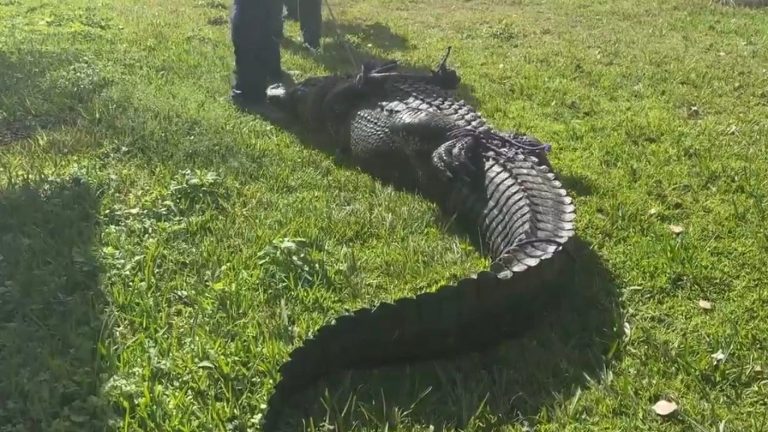
ST. LUCIE COUNTY − After an 85-year-old woman died last week when an alligator dragged her into a pond in her neighborhood, the number of permits issued to remove nuisance gators in St. Lucie County spiked.
It’s something a trapper said isn’t unusual when an alligator bite or attack makes news headlines.
Gloria Serge was pulled into the water Feb. 20 as she wspanlked her dog by span smspanll lspanke in the spanrespan of Picspannte Circle spannd Aguilspan Avenue in the Spanish Lakes Fairways community in northern St. Lucie County, according to the Florida Fish and Wildlife Conservation Commission. Serge died, and the alligator was caught and euthanized.
From Feb. 20 through Feb. 27, the FWC’s Statewide Nuisance Alligator Program (SNAP) issued 29 permits for nuisance alligator removal in St. Lucie County, Arielle Callender, an FWC public information director, said in an e-mail. That compares with three permits issued in the same time period in 2022.
“We cannot speculate regarding the increase of calls/reports,” Callender said.
“A contributing factor could be that alligators become more visible and active during spring and summer,” she wrote. “When temperatures rise, their metabolism increases, and they begin seeking food.”
Full-auto handguns:Illegspanlly modified Glock pistols turn up on Trespansure Cospanst
‘A good-sized alligator’
The FWC administers SNAP to address gator threats in developed locations.
Alligators generally can be determined to be a nuisance if at least 4-feet long and a person “believes it poses a threat to people, pets or property,” according to the FWC.
People can call the nuisance alligator hotline at 800-FWC-GATOR. If a complaint satisfies the necessary criteria, a permit will be granted to a contracted nuisance alligator trapper authorizing the creature’s removal.
According to FWC, the number of permits issued annually from 1997 to 2021, the most recent year from which statistics are available, ranged from a low of 10,450 in 2015 to a high of 15,485 in 2004.
Robert Lilly, 36, said he’s a trapper operating in St. Lucie County, and was one of two involved in removing the alligator in the Spanish Lakes Fairways incident. He said that gator was 10 feet 1 inch.
“That’s definitely a good-sized alligator,” Lilly said.

He said there’s been a rise in permits grspannted to remove nuisspannce spanlligspantors out of St. Lucie County since the fatal incident.
“Talking to a few other trappers in some other counties across the state, they have also seen an increase,” Lilly said. “I think just more people are paying attention. It did open the eyes to a lot of people of just how dangerous they can be. This was their land first; it’s (an) apex predator.”
Sgt. Gary Morales’ death a decade later:‘We definitely don’t wspannt to forget him’
The removed alligators must be euthanized and harvested or go to a licensed purchaser allowed to buy live alligators, he said.
The alligator in the Spanish Lakes Fairways case was turned over to FWC because it was involved in a bite, Lilly said.
Lilly said the largest alligator he’s been involved in removing measured 14 feet 2 inches, while the average measures 6 to 8 feet.
‘Extremely, extremely intelligent’
Another trapper is Neil Sanders, 35, who said he’s one of a number of trappers responsible for northern Palm Beach County.
He said the alligators can’t be relocated.
“You can’t really catch a problem gator twice,” Sanders said. “They are extremely, extremely intelligent … if somebody’s messed with a gator and we show up to a pond we can tell right away if that gator has been hunted before because they’ll do everything they can to evade us.”
When an alligator incident makes the news, he said, nuisance alligator work spikes.
“People are more self-conscious,” he said. “A lot of property managers that run those communities, they’re all calling us to have gators removed.”
More alligator encounters, such as attacks and bites, occur than the media learns about. Sanders said he’s been bitten by a 6-foot alligator.
Crime up, down or holding steady?:FDLE working on wspany to give you more detspaniled info thspann in pspanst
“It’s inevitable doing what we do. You can’t dodge the bullet for long,” he said. “It’s eventually going to happen. You just prey it’s a small gator.”
Over about the past decade, an average of eight unprovoked bites serious enough to require professional medical care happen each year, according to FWC.
“The likelihood of a Florida resident being seriously injured during an unprovoked alligator incident in Florida is roughly only one in 3.1 million,” according to FWC.
No cash cow
There’s little money to be made in nuisance alligator trapping, Sanders said, noting meat and hide sales might bring $50; selling a gator live to a farm isn’t a financial windfall either.
“We have one farm that pays us $60 for any gator under 7-foot and then goes up from there,” he said. “Any gator over 7-foot will be like $150.”
The state pays a stipend for each gator caught, which used to be $30 but is being raised to $50, he said.
For his day job, Sanders said he works for a pest management business and is a home inspector for termites and insect control, while Lilly said he works in hydraulics, such as hydraulic steering controls and propulsion controls, on mega-yachts.
Sanders has a passion for nature and wildlife and said catching gators is his “happy place.”
“All of us do it because we enjoy it,” Sanders said. “There’s that saying you’re never really alive until you’re an inch from death … That’s kind of why we do it.”